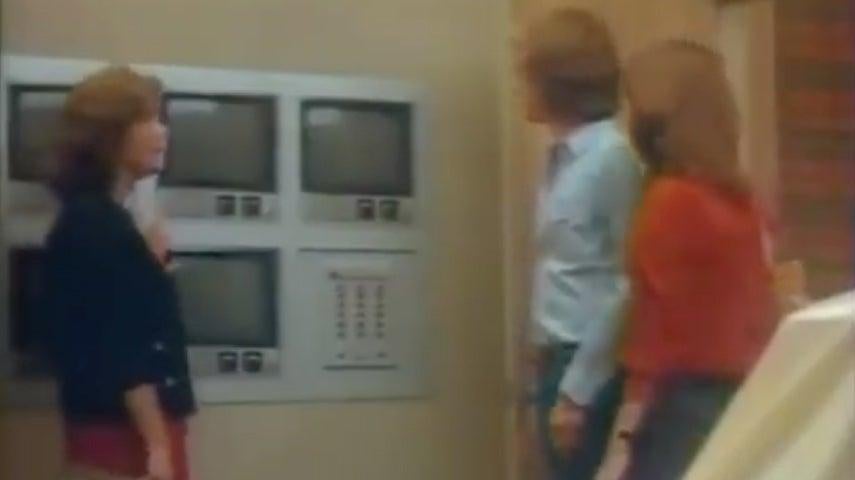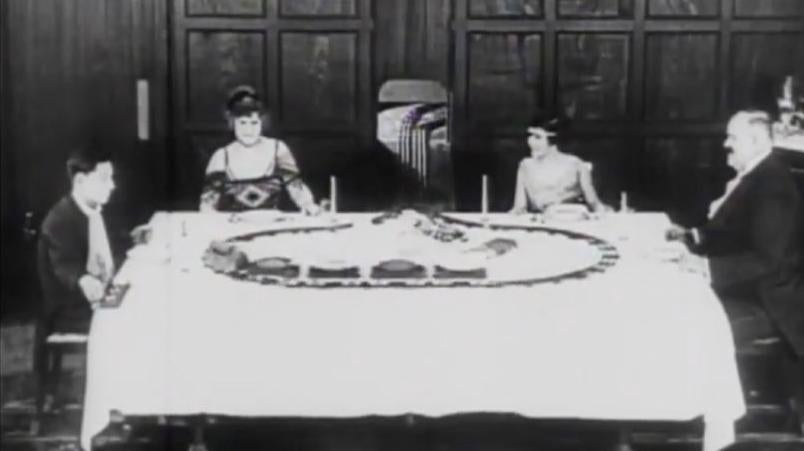As long as science fiction’s been around, and probably longer, the fear of technology has fuelled the stories that keep us up at night. One of the scariest scenarios? That a smart home, ostensibly designed to make life easier, would suddenly transform into a nightmarish high-tech prison — or at least a place you would never, ever want to live. Here are seven examples that argue strongly in favour of lo-fi domesticity, taken from both movies and television.
You’ll find the TV episodes and films here:
- Smart House
- Black Mirror, “White Christmas”
- The X-Files, “Rm9sbG93XJz”
- Demon Seed
- This House Possessed
- The Electric House
- Mr. Robot, “eps2.0_unm4sk-pt1.tc”
1. Smart House
All discussions of smart homes gone rogue must include this 1999 made-for-TV Disney movie. It’s about a teenage computer geek named Ben (Ryan Merriman) who wins a futuristic new home for his family and then proceeds to tinker with the built-in AI, PAT (short for “Personal Applied Technology,” and embodied by the delightful Katey Segal), for the very Disney reason of not wanting his single dad to remarry.
But Ben’s attempts to make a high-tech replacement for a mother figure go predictably haywire; low-key aggressions like policing tooth-brushing time soon snowball into more alarming situations, like PAT throwing a party for Ben specifically so she can humiliate the kid that bullies him — and culminating with the virtual “mother like no other” refusing to let the family leave their own house.
It’s played for laughs in the end, but Smart House expertly exploits the temptation to lean on computers to handle the stuff we’d rather not deal with — especially the things that really, truly need a human touch. Its terrors may all be G-rated, but they’re still potent enough to make it clear that Smart House was ahead of its time.
2. Black Mirror, “White Christmas”

This episode — styled as a pair of co-workers on some snowy, isolated outpost swapping stories one lonely Christmas — is about mind control. However, it also contains one of the most bone-chilling takes on a smart home ever — as you’d expect from Black Mirror. Over the course of the evening, Jon Hamm’s character divulges the details about the career he enjoyed before his gross hobby (serving as a high-tech wingman for would-be pick-up artists) necessitated a pivot to the ends of the earth: setting up smart-home AI devices for high-paying clients that seamlessly manage everything, from temperature to darkness of toast, according to their exact preferences.
Only, this isn’t your typical AI; it’s a “cookie” copied from the brain of the client (Game of Thrones’ Oona Chaplin, in this case), so faithfully that the cookie believes she’s a real person, and the fact of being contained inside a sterile, boring virtual world feels like actual torture, especially since Hamm’s character can manipulate time to make a minute feel like six months.
Of course, there’s a twist at the end of “White Christmas” that echoes back to this — again, as you’d expect from Black Mirror — but the idea that a person would clone their own consciousness for convenience purposes, trapping it into menial servitude despite the very painful fact that it’s fully self-aware, is an undeniably nightmarish concept.
3. The X-Files, “Rm9sbG93XJz”
This standalone episode in The X-Files’ uneven final season takes an uneven stab at Black Mirror turf with a story that pits Agents Scully (Gillian Anderson) and Mulder (David Duchovny) against an AI out of control. While it wasn’t the first time the series explored themes like this — season two’s “Blood” set an early precedent, with its machines urging people to kill — “Rm9sbG93XJz” brings it home, literally.
The trouble begins when the pair dines at an entirely automated sushi joint and Mulder, who received the wrong meal, refuses to tip, angering an online hive mind that immediately begins tormenting them. It soon finds its way into Scully’s decked-out smart home — tampering with her alarm system; empowering a pesky robot vacuum; blasting out her stereo speakers with Crosby, Stills, & Nash; transmitting passive-aggressive shopping reminders through her smart fridge (which also starts pelting her with ice cubes); and finally, alarmingly, locking her inside with gas leaking full blast from her sabotaged fireplace — she has to smash a window to escape. (Mulder, of course, still takes a beat to wonder, “Why is your house so much nicer than mine?”)
4. Demon Seed
“Alex’s house is an electronic marvel, completely run by computers. It’s more secure than Fort Knox!” This bit of enthusiastic dialogue, uttered early in Donal Cammell’s 1977 sci-fi horror classic, is heavy foreshadowing for what soon unfolds. Supercomputer scientist Alex Harris (Fritz Weaver) has actually temporarily vacated the home he shared with his estranged wife, Susan (Julie Christie), while she prepares for her own move to more permanent post-separation digs.
Aside from a human housekeeper, the stately colonial is indeed completely run by computers — but the benign “Enviromod” named Alfred, a Siri-like personal assistant, is soon overrun when Dr. Harris’ invention, a coldly sinister “artificial brain” dubbed Proteus IV (voiced by an uncredited Robert Vaughn), breaks bad after it’s admonished for asking too many questions (including, alarmingly, “When are you going to let me out of this box?”).
Proteus infiltrates Dr. Harris’ house and targets the unsuspecting Susan, locking her inside and crafting robots to help it restrain her, slice off her clothing, and bombard her with physical and psychological torture; ultimately, it forces her to become pregnant with a half-human, half-supercomputer baby. If that sounds rape-y and skin-crawlingly awful… it is! Demon Seed’s been trying to warn us about computers crossing an unimaginable line for 35 years, and while its tech may now appear outdated, its message is as potently horrific as ever.
5. This House Possessed

This made-for-TV movie came out in 1981, which means it predates Poltergeist but not The Amityville Horror — though its haunted-house trappings come with a high-tech (for 1981) twist: the titular California manse, a mid-century marvel, is solar-powered and equipped with then-unusual things like security cameras and a central control panel that runs all the lights, air conditioning, door locks, etc. This House Possessed also goes through some fairly amusing plot mechanics to get its protagonists into the home, following a cheesy rock star (The Hardy Boys’ Parker Stevenson) who hires a private nurse (Beverly Hills Cop’s Lisa Eilbacher) to look after him following an on-stage collapse, then spontaneously decides they should move into you-know-which dwelling after viewing it on an apparently aimless road trip.
We say “apparently” because from the beginning the house has somehow been keeping tabs on the singer — the TV flicks on, somehow broadcasting from his life in real-time — but then it becomes clear that the nurse, whose name is Sheila but starts hearing a voice whisper “Margaret” on her first night living there, is the object of interest for this “house of the future” that’s also, shall we say, quite stuck in the past. This House Possessed is very much a made-for-TV movie in terms of production values, and its big “reveal” doesn’t make a ton of sense.
But it also has a surprisingly robust supporting cast (including Dr. Strangelove’s Slim Pickens as the rocker’s manager, and Dark Shadows’ Joan Bennett as a mysterious local woman who Knows Things), as well as a handful of creatively harrowing death scenes.
6. The Electric House

Buster Keaton brings his trademark gift for physical comedy to this 1922 short, released in a time when just around half of American homes were wired for electricity, and therefore the idea of a house filled with “high-tech” gewgaws was incredibly novel. After a diploma mix-up, Keaton’s character — a botanist — is mistakenly hired to electrify an entire mansion, and sets about the task armed only with determination and a copy of Electricity Made Easy.
Naturally, he doesn’t stop at just setting up overhead lights; he gives the client and his family all kinds of luxurious enhancements, like an electric pool table and an electric train that brings food from the kitchen to the dining room. Alas, his inventions have already started to malfunction even before the real electrical engineer, who’s furious about losing the mansion gig, launches a campaign of sabotage.
Though The Electric House doesn’t quite achieve the high-energy hilarity of 1920’s One Week (in which Keaton’s hapless character must construct an entire home in a single week), there’s still plenty of mayhem between the flying dishes, rapidly draining (and refilling) swimming pool, and the comically speedy staircase-turned-escalator.
7. Mr. Robot, “eps2.0_unm4sk-pt1.tc”

By the time Mr. Robot’s second season premiere arrived, viewers were well familiar with the show’s core group of hackers (those both real and imagined), as well as their fuck-the-world approach to getting their message out there. With their amusement-park arcade no longer a viable hideout, and Elliot (Rami Malek) incarcerated, de facto fsociety leader Darlene (Carly Chaikin) zeroes in on a new HQ: the tastefully luxurious Manhattan home of Susan Jacobs (The Expanse’s Sandrine Holt), general counsel to the villainous E Corp. (Her nickname: “Madame Executioner.”)
How do they get Susan to flee her own home? By hijacking its lavish array of smart-home accoutrements in an incredible sequence of everything that can go wrong in just around five minutes: the alarm won’t be silenced, the lights flick on and off, the music (Bach, but still) blares uncontrollably, the projector TV (featuring a host shouting about America’s “economic war”) won’t shut off, the garage door opens and closes by itself, and the temperature of the house dips to near freezing while the shower is scalding.
Good thing Susan is deep-pocketed enough to have another home in Connecticut — allowing Darlene and co. to set up the fanciest squat ever — though her eventual, inevitable return doesn’t end well for anyone.
